Conocemos esa sensación. Ese momento en el que tu sitio se cae y no tienes ni idea de por qué. Es uno de los errores más comunes de WordPress, pero también uno de los más misteriosos. No te dice lo que está mal, sólo que algo está roto.
¿La buena noticia? Casi siempre se puede solucionar. Después de haber ayudado a innumerables clientes, nos hemos enfrentado a este error con bastante frecuencia.
En esta guía, te guiaremos a través de los pasos exactos para que tu sitio vuelva a funcionar. Sólo tienes que seguir a lo largo, y usted tendrá todo funcionando de nuevo en ningún momento.
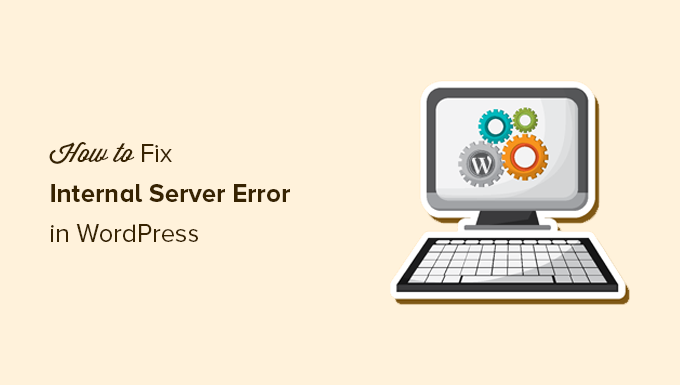
He aquí un breve resumen de los debates que abordaremos en este artículo:
- What Is the 500 Internal Server Error?
- What Causes the Internal Server Error in WordPress?
- Fixing the 500 Internal Server Error in WordPress
- Clear WordPress and Browser Cache
- Checking for Corrupt .htaccess File
- Increasing the PHP Memory Limit
- Deactivate All WordPress Plugins
- Switch to a Default WordPress Theme
- Re-Uploading Core Files
- Enable Debug Logs in WordPress
- Ask Your Hosting Provider
- Video Tutorial
¿Qué es el error 500 Internal Server Error?
El error 500 Internal Server Error es como una puerta cerrada sin llave. Sabes que algo va mal, pero no hay ninguna nota que explique qué ha pasado.
Este error no es sólo un problema de WordPress. Puede aparecer en cualquier sitio web cuando el servidor se encuentra con un problema que no sabe cómo resolver.
El “500” del mensaje es un código de estado HTTP. Si lo buscas, encontrarás una vaga definición:
“El código de respuesta 500 Internal Server Error indica que el servidor encontró una condición inesperada que le impidió cumplir con la solicitud”.
Eso no es muy útil, ¿verdad? Es la forma que tiene el servidor de decir: “Algo se ha roto, pero no estoy seguro de qué”.
El aspecto de este error depende de la configuración de su alojamiento y de su navegador. Aquí tienes un ejemplo de cómo aparece en un servidor Apache:
Si su sitio se ejecuta en Nginx, puede parecer un poco diferente. Y si Google Chrome no puede cargar una página de error adecuada, verás algo como esto:
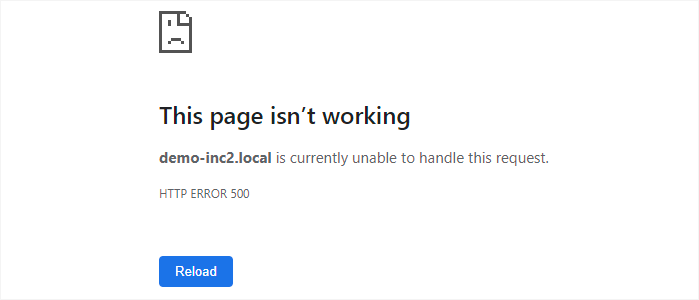
Para los principiantes, esto puede resultar abrumador. No hay ningún mensaje que explique qué ha fallado o cómo corregirlo.
Es como pedirle a un mecánico que te corrija el coche sin decirle qué se ha estropeado. Tendrán que marcar / comprobar distintas piezas hasta encontrar el problema / conflicto / incidencia.
Según nuestra experiencia, la mejor manera de corregirlo es hacerlo paso a paso. Te guiaremos a través de las causas y soluciones más comunes para que puedas hacer que tu sitio vuelva a funcionar.
Obtenga ayuda experta en cualquier momento con el soporte de WordPress bajo demanda.
Tratar con un error interno del servidor puede ser frustrante. Nuestro soporte de WordPress bajo demanda está aquí para ayudarle a corregir problemas técnicos de forma rápida y eficaz.
- Pago único para recibir soporte experto a la carta
- Plazos de entrega rápidos
- Disponible 24 horas al día, 7 días a la semana
¿Qué causa el error interno del servidor en WordPress?
El error interno del servidor en WordPress es como un puzzle al que le faltan piezas. Sabes que algo va mal, pero el mensaje de error no te dice exactamente dónde está el problema.
Según nuestra experiencia, el culpable más común es un archivo .htaccess corrupto. A veces, es un plugin o un tema que no funciona bien con tu configuración.
Otras veces, su sitio puede alcanzar el límite de memoria PHP, haciendo que WordPress se bloquee. Los archivos del núcleo corruptos también pueden desencadenar este error, dejándole bloqueado sin advertencia.
En algunos casos, el error solo aparece al intentar acceder al área de administración de WordPress, mientras que el resto del sitio funciona correctamente. Es como quedarse fuera de casa mientras los invitados pueden entrar por la puerta de atrás.
Lo que hace que este error sea complicado es que suele producirse antes de que WordPress pueda cargarse correctamente. Eso significa que el servidor no puede reunir suficientes detalles para explicar qué ha ido mal.
Si quieres saber cómo funciona WordPress entre bastidores, marca / comprueba nuestra guía sobre cómo funciona WordPress bajo el capó.
A continuación, vamos a diagnosticar los problemas para que su sitio vuelva a funcionar.
Corrección del error 500 Internal Server en WordPress
Antes de empezar a diagnosticar problemas, asegúrese de tener a mano una copia de seguridad completa de WordPress de su sitio web.
Si tiene acceso al área de administrador de WordPress, puede utilizar un plugin de copia de seguridad de WordPress para crear una copia de seguridad completa de su sitio web.
Recomendamos usar Duplicator para manejar esto. No solo te ayuda a hacer copias de seguridad rápidas de tu sitio web, sino que también puedes almacenar tus copias de seguridad en la nube y, lo que es más importante, puedes restaurar tu sitio web desde la copia de seguridad.
Por otro lado, si no tiene acceso al área de administrador de WordPress, puede crear manualmente una copia de seguridad de WordPress utilizando phpMyAdmin y un cliente FTP.
A continuación, puede seguir los siguientes pasos para diagnosticar y corregir el error interno del servidor en su sitio web.
Vaciar la caché de WordPress y del navegador
Los navegadores y sus plugins de caché de WordPress pueden a veces almacenar por error una copia en caché de una página de error.
La forma más fácil de corregirlo es vaciando primero la memoria caché del navegador.
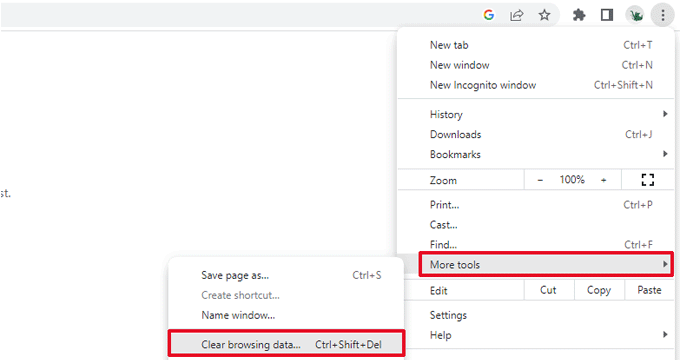
Después, si tiene acceso al área de administrador de WordPress de su sitio web, puede vaciar la caché de WordPress visitando la página de ajustes de su plugin de caché.
Para más detalles, consulte nuestro tutorial sobre cómo vaciar la caché de WordPress.
Comprobar si el archivo .htaccess está dañado
El archivo .htaccess es un archivo de configuración del servidor utilizado por WordPress para establecer las redirecciones.
Una de las causas más comunes de error interno del servidor es el archivo .htaccess corrupto.
La forma más fácil de establecer esto es simplemente visitando la página de Ajustes ” Enlaces permanentes en el área de administración de WordPress y luego haciendo clic en el botón “Guardar cambios” sin hacer ningún cambio.
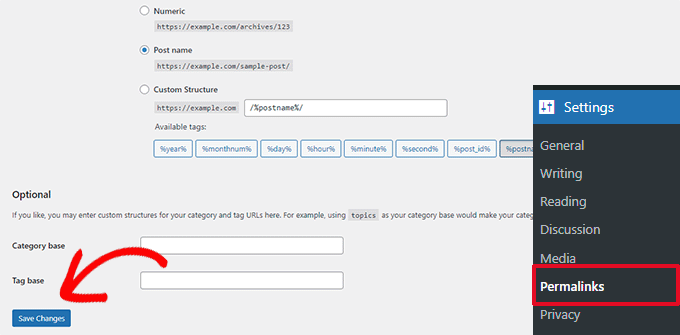
WordPress intentará actualizar su archivo .htaccess o generar uno nuevo. Ahora puede visitar su sitio web para comprobar si se ha resuelto el error interno del servidor.
Si aún puede ver el error, entonces necesita asegurarse de que WordPress pudo generar o escribir en el archivo .htaccess.
A veces, debido a los permisos de archivos y directorios, es posible que WordPress no haya podido crear o escribir en su archivo .htaccess.
Ahora puede intentar reemplazar el archivo .htaccess manualmente. En primer lugar, debe acceder a su sitio web mediante FTP o la aplicación Administrador de archivos del panel de control de su cuenta de alojamiento.
A continuación, debe renombrar suarchivo .htaccess principal a algo como .htaccess_old. Esto le permite mantener el archivo como una copia de seguridad, pero WordPress no lo reconocerá.
Para cambiar el nombre del archivo .htaccess, deberá acceder a su sitio mediante FTP o la aplicación Administrador de archivos del panel de control cPanel de su cuenta de alojamiento.
Una vez conectado, el archivo .htaccess estará ubicado en el mismo directorio donde verá carpetas como wp-content, wp-admin y wp-includes.
Simplemente haga clic con el botón derecho en el archivo .htaccess y cámbiele el nombre a .htaccess_old.
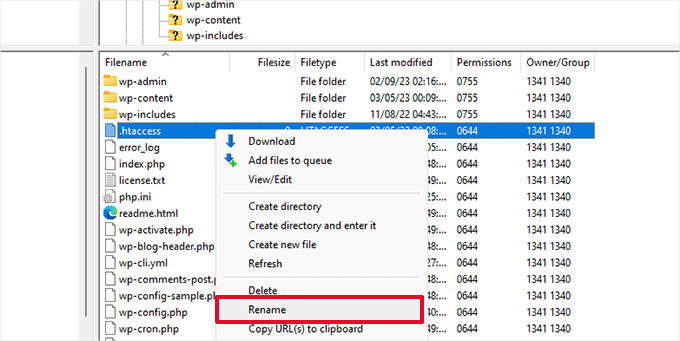
A continuación, debe crear un nuevo archivo .htaccess.
Dentro de la carpeta raíz de su sitio, haga clic con el botón derecho del ratón y seleccione la opción “Crear nuevo archivo” en su cliente FTP o aplicación de gestión de archivos.
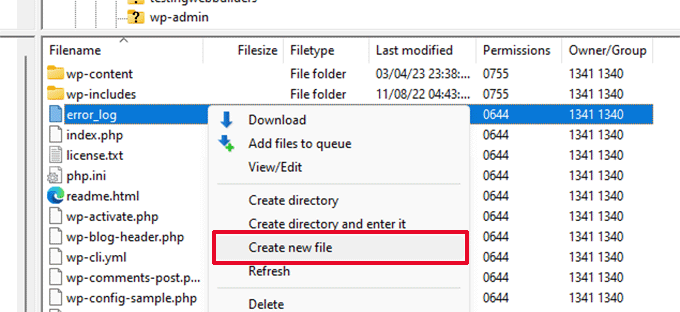
Nombre este nuevo archivo .htaccess y haga clic en “Aceptar” para guardarlo.
Ahora, este archivo .htaccess está actualmente vacío, y necesita añadirle reglas de reescritura por defecto de WordPress.
Sólo tienes que hacer clic con el botón derecho en el archivo y seleccionar “Ver/Editar” en tu cliente FTP o aplicación de gestión de archivos.
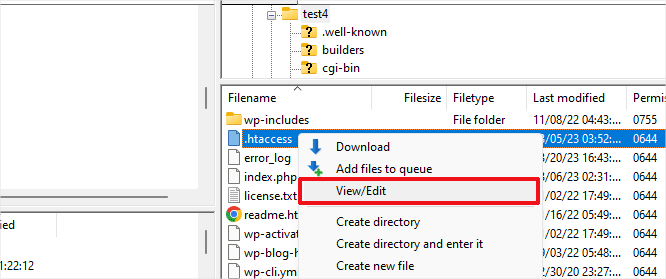
El archivo vacío se abrirá en un editor de texto plano como Notepad o TextEdit.
Ahora, tienes que copiar y pegar el siguiente código en su interior:
1 2 3 4 5 6 7 8 9 10 | # BEGIN WordPress<IfModule mod_rewrite.c>RewriteEngine OnRewriteBase /RewriteRule ^index.php$ - [L]RewriteCond %{REQUEST_FILENAME} !-fRewriteCond %{REQUEST_FILENAME} !-dRewriteRule . /index.php [L]</IfModule># END WordPress |
Este código es el conjunto de reglas por defecto utilizado por WordPress. No olvide guardar los cambios y volver a subir el archivo al servidor.
Ahora puede visitar su sitio web para comprobar si se ha resuelto el error interno del servidor.
Si es así, date una palmadita en la espalda porque has corregido el error interno del servidor.
Importante: Antes de continuar con otras cosas, asegúrese de ir a la página Ajustes ” Enlaces permanentes en el área de administrador de WordPress y haga clic en el botón Guardar sin realizar ningún cambio. Esto regenerará el archivo .htaccess con las reglas de reescritura adecuadas para garantizar que las páginas de entradas no devuelvan un error 404.
Si la solución de comprobar si el archivo .htaccess está corrupto no le ha funcionado, entonces tiene que seguir leyendo este artículo.
Aumentar el límite de memoria PHP
A veces, el error interno del servidor puede ocurrir si un script consume todo el límite de memoria PHP.
La forma más fácil de aumentar el límite de memoria PHP es editando el archivo wp-config.php. Tenga cuidado al hacer esto si usted es un principiante. Usted quiere seguir estas instrucciones cuidadosamente porque incluso pequeños errores en los archivos del núcleo de WordPress pueden romper su sitio.
Para empezar, sólo tiene que conectarse a su sitio web WordPress mediante un cliente FTP o la aplicación Administrador de archivos del panel de control de su cuenta de alojamiento.
Encontrarás el archivo wp-config.php dentro de la carpeta principal de tu sitio web. Haz clic con el botón derecho y selecciona “Descargar”. Esto te asegurará que tienes una copia de seguridad del archivo en caso de que algo vaya mal.
Cuando lo hayas guardado, puedes hacer clic con el botón derecho y seleccionar “Ver/Editar”.
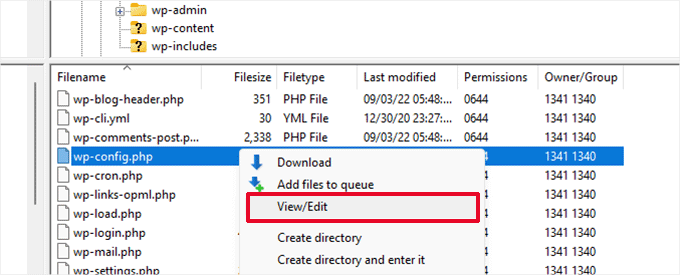
Dentro del archivo wp-config.php, debe añadir el siguiente código justo encima de la línea que dice: ‘¡Eso es todo, deje de editar! Feliz publicación’:
1 | define( 'WP_MEMORY_LIMIT', '256M' ); |
Para más detalles, consulte nuestro tutorial sobre cómo aumentar el límite de memoria PHP en WordPress.
Nota: Si 256M no resuelve el problema, intente aumentarlo a 512M.
Si ve el error interno del servidor solo cuando intenta acceder a su administrador de WordPress o subir una imagen en su wp-admin, entonces debe aumentar el límite de memoria siguiendo estos pasos:
- Crea un archivo de texto en blanco en tu ordenador y llámalo php.ini
- Pega este código: memory=256MB
- Guardar el archivo
- Súbelo a tu carpeta /wp-admin/ usando FTP
Si aumentar el límite de memoria te ha corregido el problema, entonces solo lo has hecho temporalmente. Todavía tienes que encontrar la causa que está agotando tu límite de memoria.
Podría tratarse de un plugin mal codificado o incluso de una función del tema. Le recomendamos encarecidamente que pida a su empresa de alojamiento web de WordPress que revise los registros del servidor para ayudarle a encontrar el diagnóstico exacto.
Si al aumentar el límite de memoria PHP no se ha corregido el problema, es necesario diagnosticar más problemas.
Desactivar todos los plugins de WordPress
Si ninguna de las soluciones anteriores le ha funcionado, lo más probable es que este error esté causado por un plugin específico instalado en su sitio web.
También es posible que se trate de una combinación de plugins que no funcionan bien entre sí.
Si puede acceder al área de administrador de WordPress de su sitio web, sólo tiene que ir a la página de plugins y desactivar todos los plugins de WordPress.
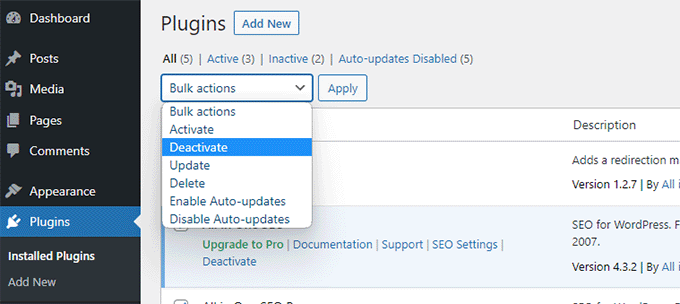
Sin embargo, si no se ha podido acceder al área de administrador de WordPress, se pueden desactivar todos los plugins de WordPress mediante FTP.
Sólo tienes que conectarte a tu sitio web WordPress mediante un cliente FTP o la aplicación de gestión de archivos del panel de control de tu cuenta de alojamiento.
Una vez conectado, vaya a la carpeta /wp-content/ y cambie el nombre de la carpeta plugins a plugins.deactivated.
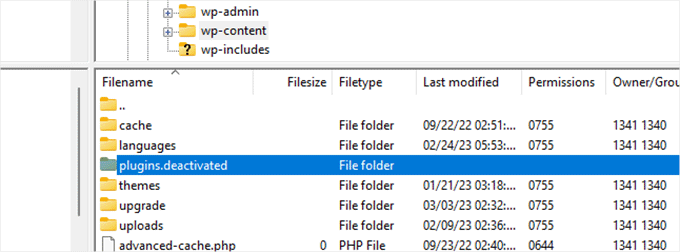
WordPress busca los plugins en la carpeta plugins. Si no encuentra la carpeta de plugins, desactivará automáticamente todos los plugins.
Ahora puede intentar visitar su sitio web para ver si esto ha resuelto el error interno del servidor en su sitio web.
Para restaurar todos tus plugins, puedes simplemente renombrar la carpeta ‘plugins.deactivated’ de nuevo a plugins.
Tus plugins se restaurarán, pero seguirán desactivados.
Ahora puede activar plugins individualmente y visitar su sitio web para averiguar qué plugin está causando el error interno del servidor.
Para más detalles, consulte nuestra guía sobre cómo desactivar todos los plugins de WordPress sin wp-admin.
Si la desactivación de todos los plugins no ha corregido el error interno del servidor en su sitio web, siga leyendo.
Cambiar a un tema predeterminado de WordPress
Una posible causa del error interno del servidor podría ser algún código de su tema de WordPress.
Para determinar si este es el caso, necesita cambiar su tema a un tema por defecto de WordPress.
Si tiene acceso al área de administrador de WordPress, vaya a la página Apariencia ” Temas. Si tienes un tema por defecto ya instalado, entonces puedes simplemente hacer clic en el botón Activar para cambiar el tema.
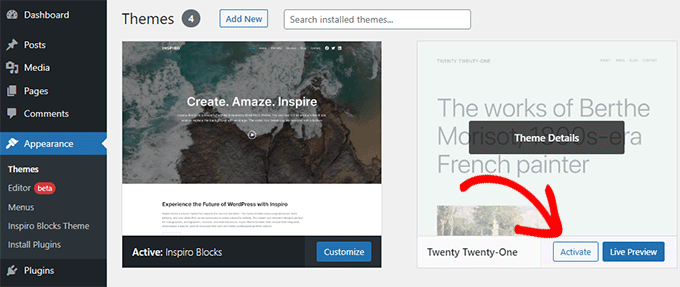
Si no tiene instalado un tema por defecto, puede hacer clic en el botón “Añadir nuevo” de la parte superior e instalar un tema por defecto (Twenty Twenty-Three, Twenty Twenty-Two, etc.).
Si no tienes acceso al área de administrador de WordPress, puedes cambiar a un tema por defecto.
Simplemente conéctese a su sitio web WordPress utilizando un cliente FTP y navegue hasta la carpeta /wp-content/.
Haz clic con el botón derecho para seleccionar la carpeta de temas y descárgala en tu ordenador como copia de seguridad.
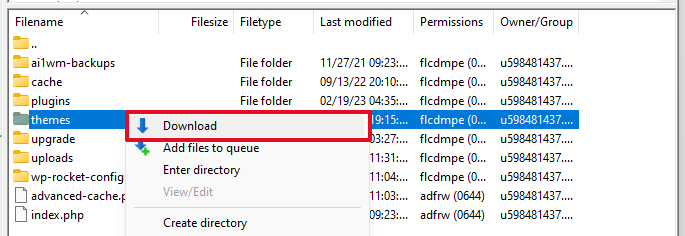
Lo siguiente que tienes que hacer es borrar la carpeta de temas de tu sitio web. Una vez que se borra, seguir adelante y crear una nueva carpeta de temas.
Su nueva carpeta de temas estará completamente vacía, lo que significa que no tiene ningún tema de WordPress instalado en este momento.
A continuación, debe visitar el directorio de temas de WordPress y descargar un tema de WordPress por defecto en su ordenador.
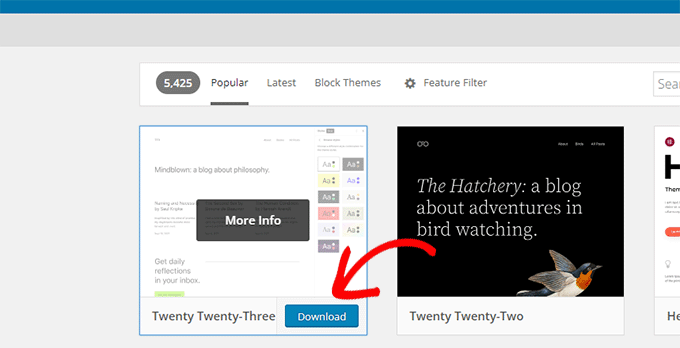
A continuación, su navegador descargará el tema como archivo zip en su ordenador.
Localice el archivo en su ordenador y descomprímalo. Los usuarios de Windows pueden descomprimir el archivo haciendo clic con el botón derecho y seleccionando “Extraer todo”. Los usuarios de Mac pueden hacer doble clic en el archivo zip para extraerlo.
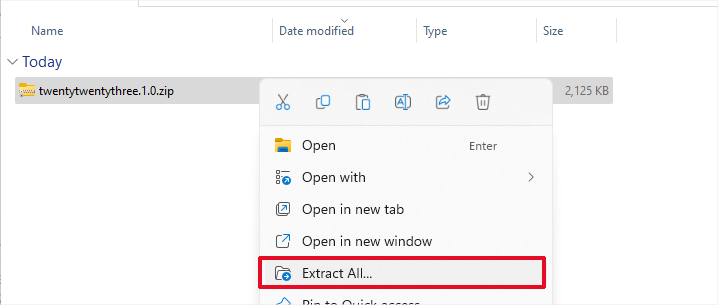
Ahora verá una carpeta que contiene su tema de WordPress.
Vuelva a su cliente FTP o al gestor de archivos y suba esta carpeta a la carpeta de temas vacía.
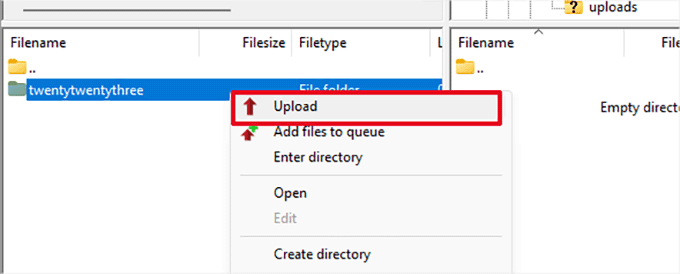
Una vez subido, WordPress empezará a utilizar automáticamente el tema por defecto.
Ahora puede visitar su sitio web para comprobar si se ha resuelto el error interno del servidor.
Si esto no funciona, puede volver a cargar sus temas de WordPress desde la copia de seguridad o volver al tema que estaba utilizando.
No se preocupe. Todavía hay algunas cosas más que puede hacer para corregir el error.
Volver a subir archivos del núcleo
Si las opciones del plugin y del tema no han corregido el error interno del servidor, vale la pena volver a cargar las carpetas /wp-admin/ y /wp-includes/ desde una nueva instalación de WordPress.
Esto NO eliminará ninguno de sus datos, pero puede solucionar el problema en caso de que algún archivo esté dañado.
En primer lugar, tendrás que visitar el sitio web WordPress.org y hacer clic en el botón “Descargar”.
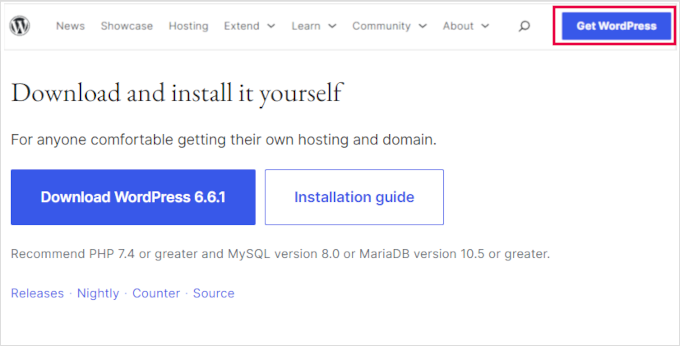
Esto descargará el archivo zip de WordPress en su ordenador.
Extraiga el archivo zip. Dentro de él, encontrará una carpeta wordpress.

A continuación, debe conectarse a su sitio web WordPress mediante un cliente FTP.
Una vez conectado, vaya a la carpeta raíz de su sitio web. Es la carpeta que contiene las carpetas wp-admin, wp-includes y wp-content.
En la columna de la izquierda, abra la carpeta WordPress de su ordenador.
Ahora tienes que seleccionar todos los archivos dentro de la carpeta de wordpress y subirlos a tu sitio web.
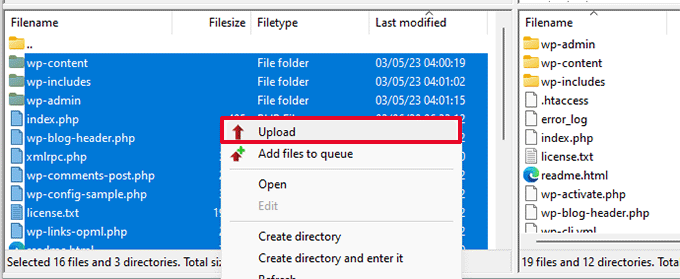
Tu cliente FTP transferirá ahora esas carpetas a tu servidor.
Le preguntará si desea sobrescribir los archivos. Seleccione “Sobrescribir”, luego seleccione “Utilizar siempre esta acción” y marque la casilla de verificación “Aplicar solo a la cola actual”.
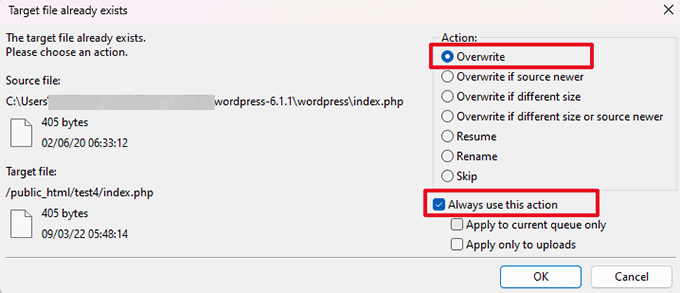
Su cliente FTP sustituirá sus archivos antiguos de WordPress por copias nuevas y actualizadas.
Si sus archivos de WordPress se corrompieron, este paso corregirá el error interno del servidor.
Activar los registros de depuración en WordPress
WordPress viene con un sistema incorporado para mantener los registros para depurar.
Puedes activarlo usando el plugin WP Debugging. Para más detalles, consulta nuestra guía sobre cómo instalar un plugin de WordPress.
Una vez activado, el plugin activará los registros de depuración en su sitio web WordPress.
Si no tiene acceso al área de administrador de su sitio web WordPress, puede activar la depuración añadiendo el siguiente código a su archivo wp-config.php:
1 2 | define( 'WP_DEBUG', true);define( 'WP_DEBUG_LOG', true); |
Una vez que haya activado los registros de depuración, puede verlos utilizando un cliente FTP y navegando hasta la carpeta /wp-content/.
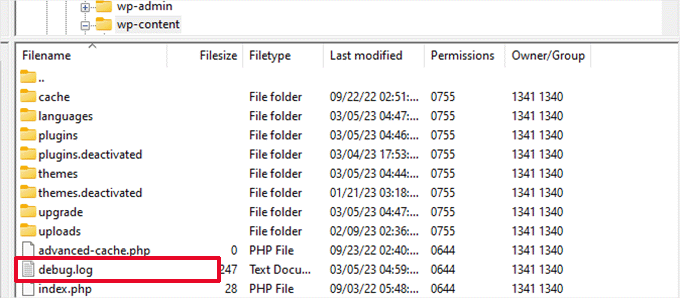
Puede abrir el archivo de registro de depuración en un editor de texto, y se le mostrará una lista de los errores y advertencias que se producen en su sitio web.
Algunos errores y advertencias pueden ser incidentes inofensivos que no necesitan corrección. Sin embargo, si ves un error interno del servidor en tu sitio web, entonces estos pueden indicarte la dirección correcta.
Pregunte a su proveedor de alojamiento
Si todos los métodos fallan a la hora de corregir el error interno del servidor en su sitio web, entonces es el momento de obtener algo más de ayuda.
Póngase en contacto con el equipo de soporte de su alojamiento web, y ellos podrán marcar / comprobar los registros del servidor y localizar la causa del error.
Si quieres seguir diagnosticando por tu cuenta, consulta nuestra guía definitiva para diagnosticar problemas en WordPress para principiantes.
Tutorial en vídeo
If you liked this article, then please subscribe to our YouTube Channel for WordPress video tutorials. You can also find us on Twitter and Facebook.




Ivan
Also, how to create an .ini file on a mac???
Ivan
What if it’s NOT the .htaccess file? Can we then change the filename back .htaccess??
What if it’s NOT the plugins? Can we simply change the plugins folder name back to what it was??
These are details we should know about.
Thanks!
WPBeginner Support
Yes, if it was not due to plugins folder or .htaccess, then you can put them back as they were.
Admin
gks
thanks this was so helpful.
philip
Thankyou so much, I had installed a plugin which had somehow corrupted the .htaccess file, renamed it to .htacces_old as per the advice on this page, and all’s back working again, if you cant find the .htaccess file on your server, it could be hidden, cpanel has an option to look for hidden files.
thanks guys
Akinshola Samuel
When all the files in your “wp-content” are empty, you always get the server (both locally and remotely). Took me longer time before recognising this.
I was moving the an existing wordpress engine alognside many other things, Unfortunately the wp-contents and it’s respective folders were all empty.
Finally, Happy when I solve this.
Max B
Thank you guys for saving my day! This solved the issue for me, thank you!
Sofia Berglund
Thanks! Great tutorial. Turned out for me that, when I was unactivated the plugins, I got another error-message saying i had some corrupt @media print-code in the functions.php. Took that away and got my page back
Donald
Make sure index.php has permissions of 644. Somehow mine has 777 when transferred from one server to another.
John
DONALD !!! you’re a life saver … thanks to the WP beginner platform also
Lewis James-Odwin
Great Video, solved my problem in 54 seconds! (.htaccess issue)
Keek
I must have spent 4 hours trying everything I found online. In the end, turns out I was running an old version of PHP. When I updated it in my cPanel, the 500 error was gone.
krishna
Internal Server Error
The server encountered an internal error or misconfiguration and was unable to complete your request.
Please contact the server administrator, webmaster@ and inform them of the time the error occurred, and anything you might have done that may have caused the error.
More information about this error may be available in the server error log.
Additionally, a 500 Internal Server Error error was encountered while trying to use an ErrorDocument to handle the request.
how to solve this error?
M Jones
My problem was actually a corrupt wp theme rather than a corrupt plugin.
To solve I renamed the corrupt theme (Oxygen) (which gave me a white screen) than named Twenty Sixteen “oxygen” so that my site would use Twenty Sixteen (a working theme) as my theme. Than I switched using dashboard to Twenty Fourteen (my second favorite installed theme) than again used my file editor to rename Twenty Sixteen back to “twentysixteen” & Oxygen to “oxygen.corrupt”.
I think my theme did not download properly, making it corrupt.
Thanks for pointing me in the right direction!
Alia
Thank you so much you saved me a lot of time!
mayur
Thank you so much for so complet information!
i have a .htaccess problem.. solved.. now working as charm..
SHYOPAT
Someone pointed me to your article (thank heavens) I did the htaccess file change and it helped it for two minutes. Then I did the php memory thing and that helped for a few minutes as well, then back to the internal server error. I’m currently working on trying to figure out if it’s a plugin. If that doesn’t help… then I’ll do the core files. And then after that… I have no idea. I guess I’ll try my hosting provider again.
Den
I always check .htaccess file first…
Will Paro
Is it possible to have an Internal Server Error only on select computers, but not others?
That is the issue I’m dealing with right now.
I have 6 sites all hosted through one account via GoDaddy. All are showing an Internal Server Error. They were fine this morning, but now nothing.
Problem is that GoDaddy says that they see the sites just fine.
I can pull the site up in gtmetrix.com and analyze it with no issues.
Please help.
Every computer I use PC, Macs and Chromebooks all show internal server errors, but gtmetrix.com and GoDaddy says everything is fine.
One of the sites is
Thanks in advance
Jesu
You save my life!!
Thanks a lot from Spain!
antony agnel
Phew…thanks a lot guys!
A new guy here…installed ‘bulletproof security’ plugin on my wordpress site & got an Error 500!
Was shit scared…& finally found out about your site and this article – finally fixed it by applying your tip to rename to .htaccess file to .htaccess_old!
Once again, thank you so much – you guys rock!!
hendra
Hi Guys
I have a questions in regards of 500 internal server error, i experienced the problem with a plugins [JSON API] when i type example.com/api/ – it is showing 500 internal server error.
any advises on how to solve this problem? much appreciated before.
Linda
Thank you!
In my case, it was the theme that was broken (my fault for tinkering around), not a plugin. I renamed the theme folder .mytheme-deactivate like in your plugin example, and hallelujah, I could access my site again! (I simply activated a different theme, but I could probably uninstall and re-install the original theme if I wanted to)
Aviroop Chowdhury
Disabling solved my issue. Thanks.
Mike
Sometimes this is a bug in your own PHP code.
For this it’s best to use a binary chop ‘echo’ method. That is add a simple echo ‘fred1’; exit; into your code starting at the top of the index.php. If you see ‘fred1’ displayed when you visit your site then you know it’s a PHP bug and not any of the other reasons. (Note I used a .htaccess online validator to check the syntax of my .htaccess file too, in order to rule that out).
Once ‘fred1’ is displayed now move it halfway down the index.php file (useful to increment the integer each time too, e.g. fred2, fred3 etc). If the server error occurs then you know you need to move the statement up. If fred1 etc is printed then you need to move it further down the code. If you get to an include or require statement then you then delve into that file in the same way.
I found the offending PHP file in under 10 minutes. You should then use php -l whateverfile.php to find offending line in that file and also to know what the syntax error is. If ‘php -l’ doesn’t give you the syntax error then you should read this:
The ‘php -l’ would need to be done by remote logging into your hosting account. If you can’t do this then as this article says, contacting your hosting support can be useful to find the php log file.
Darrin
You’re a life-saver! Renaming my plugins directory worked. Thank you!
Peter Ishola
I have tried all the options given in this article but it’s still the same. the error message appears on both the admin and the web pages of my site. I’d appreciate more options to solve this problem. The error message is:
500 – Internal server error.
There is a problem with the resource you are looking for, and it cannot be displayed.
Thanks
Kristoff
I am running a large WooCommerce store and was receiving 500 internal server error on most front end pages & WP admin login. The store resides on a dedicated cloud server and had been running fast without fault for a few months. Tried ht access remedy firstly, but nothing changed, php memory should not have been a problem as I had increased this on install & I did not think WP ftp core files were corrupted, so looked elsewhere. Ran putty to connect to dedicate linux server and command line was showing huge CPU usage for mysql – 90%. Previously in my WP development experience sql errors or high usage are database related, so via a combination of sql workbench to kill connections & php myadmin to repair database tables (I only repaired wp_options in this instance) I was able to fix the internal server problem. My point on all of this is – even though problem was flagged as internal server error, it was a database table repair (after table analysis) which cleared the error.
sahni
Can you write in detail how did you do fix wp_options
Saheed
Thanks a lot, deactivating plugins solved my issue
Dan
Hey Guys ,
I have this problem right now with some site and it looks like it is because server is overloaded and website is on shared hosting, so keep an eye on that !
Janus
Thanks i think you are right, i tried all above solutions but nothing helped, and i have pinge my site to a lot of search engines today so can be robots from there that have made the error.
Julian
Thank you! Deactivating the plugins vía PhpMyAdmin worked for me!
Monayam Ahmad
Not work for me. I face this problem when I want to customize my theme. Everything goes well. But to do ‘customize’ I get this error. I don’t why.
Ben
Thank you very much for this very helpful article !
The htaccess renaming worked for me ! Yeah !
Joe
Thank you so much! I was encountering endless Internal Server Errors for about 36 painful hours, and deleting/reuploading my theme via FTP then renaming the .htaccess file SAVED ME SO MUCH!
You are a life saver.
oladayo
Thank you very much. it was the option of re-uploading the wp-admin and include folders that saved me after about 3weeks of troubleshooting.
Rod Salm
For me, it was the permissions setting for the entire directory. It needed to be 750. Soon as I changed that in the File Manager in cPanel it was back up.
I didn’t figure that out on my own.
Rod
Giorgio
Thank you so much! You save me from an heart attack…
Simply I have renamed, via FTP, the .htaccess in .htaccess_old, and WP goes on.
This is the new .htaccess, created as you suggested:
# BEGIN WordPress
RewriteEngine On
RewriteBase /
RewriteRule ^index\.php$ – [L]
RewriteCond %{REQUEST_FILENAME} !-f
RewriteCond %{REQUEST_FILENAME} !-d
RewriteRule . /index.php [L]
# END WordPress
This is the .htaccess that I find in my FTP and renamed in .htaccess_old:
## BEGIN WordPress<
RewriteEngine On
RewriteBase /
RewriteRule ^index\.php$ – [L]
RewriteCond %{REQUEST_FILENAME} !-f
RewriteCond %{REQUEST_FILENAME} !-d
RewriteRule . /index.php [L]
# END WordPress
I don’t know what had modify the file. Someone have an answer?
Thank you!
Donny
I think it is a # problem, because your old file has 2 # and the new 1 # in the beginning.
Hope it helped
Oderinde Taiwo Martins
I just want to say a big thank you to you guys. You saved my day with this article. I’m bookmarking this website now as I know I will have to come back and learn more from your resources. Thanks a bunch.
Rionize
tkank’s guys every thing is on .htaccess file and pemalink in word press check it out!!!
Petrus Rex
I had this issue after a fresh install of WordPress. I would get this error specifically when accessing the plugins from my dashboard it turned out to be a corrupt .htaccess file but had to be handled server side by my web host. I’m running on Arvixe.
abbas
thanks
Ivan Aliku
I must give kudos to the moderators and content developers of this blog. I’ve not regreted knowing this website for one bit. The .htaccess solved the problem for me with ease. Keep up the good work.
Being Khan
I can’t rename it even.
Petrus Rex
You can change the name with an FTP client after you transfer it to your web host.
Usman Aslam
Thanks a lot, it was due to a bad plugin I couldn’t login, Wouldn’t have been possible without reading this. Great work … !
Larah31
Thanks man.. You’re the best
Cory
Thanks, renaming .htaccess to .htaccess.old did the trick :).
Mitch
I’ve got a weird one. My Internal Server Errors only happen on “Posts”, and Not on “Pages”. The host just updated the PHP version as well as the memory limit, and I re-uploaded the wp-admin and wp-admin files. No luck. Any other ideas?
James
I have the same issue. None of these things fixed it for me either.
josh
thanks this was helpful
mark
.htaccess did the thing for me. Thanks!
Juan mejia
Thanks!!!! htaccess in my case.
Cachi
Thanks, It solved in my case. Just delete de .htaccess , reload, and a new .htaccess file was generated and the site works !
Thank you again
Rochelle
I have been in touch with my hosting provider two times and they have no idea what it is. They switched databases, thought it was hacked, and the other guy couldn’t figure out why I was having problems at all.
Someone pointed me to your article (thank heavens) I did the htaccess file change and it helped it for two minutes. Then I did the php memory thing and that helped for a few minutes as well, then back to the internal server error. I’m currently working on trying to figure out if it’s a plugin. If that doesn’t help… then I’ll do the core files. And then after that… I have no idea. I guess I’ll try my hosting provider again.
Would switching hosts be of any help at all?
WPBeginner Support
If all these steps don’t help and your host is unable to assist, then yes you can consider switching to a better WordPress hosting.
Admin
Adela
Thank you so much for so complet information!
It was a plugin problem for me, impossible to find without your help!